Quest for a King (Kingfish on the fly, that is...)
- Joe Walker

- Jan 18, 2023
- 10 min read
Updated: Jan 19, 2023
Expectation. One simple word, but a difficult emotion to control. Add in the fuel provided through mediums like Facebook and those little flames can become a raging furnace of the imagination, in which glowing angling aspirations are forged. We are, after all, an optimistic lot or we wouldn’t fish to start with… and expectation is the ember that ignites our excitement afresh, every time, no matter what previous failures we may have endured.
Small wonder then that my long overdue inaugural trip to New Zealand was heavily laced with expectations for all sorts of things, but right up there was the chance to experience the raw power of the extraordinary kingfish, the most prized saltwater gamefish in New Zealand and a real challenge on the fly.

The Yellow Tail Kingfish (aka. Haku, Kingfish or "Kingie") is a tough, torpedo of a game-fish - aggressive, strong and regularly found in groups or shoals. Found mostly around the North Island of New Zealand during the summer months, Kingfish are incredible sport on fly rods!
The basics: A 9wt saltwater rod is the ideal tool for the job, matched to a good saltwater-proof reel and a tough, sealed drag ... you'll need it! The standard approach with leaders seems to be 9ft of 30lb flouro, straight-through (but take some 20lb with you too). On the flats, floating lines and intermediate sink-tips work well. We'll talk flies further down
If fishing from a boat, no waders are required, but fishing the flats from the shore will need the usual kit. Remember that New Zealand has incredibly strict bio-security rules. You must declare your fishing gear on the customs form and present it for inspection when you retrieve your luggage. It'll have to be meticulously cleaned before you go - if you turn up with ANY with mud or algae on any of your gear (including the very soles of your boots) you could well end up having it impounded until you leave... so if you're going, get scrubbing!
Given that my trip involved a pretty tight touristy schedule, I did my homework, booked some time in Tauranga, south of Auckland and the location of a world class fishery, and secured the highly regarded services of Julian Danby, an experienced river and saltwater guide. Julian’s knowledge of the Tauranga harbour flats would be just what I needed to tip the odds in my favour and the photos on his web pages certainly had me salivating at the prospect of contact with one of these yellow-tailed meanies.
My expectations were further stoked when I came across a remarkable Facebook group (a private group called Salt Fly Tauranga) run by local Tauranga fly anglers and kingfish experts, Dick Marquand and Mike Limmer. Dick’s energy, enthusiasm and experience (which had yielded over 200 ‘kingies’ and counting) was nothing short of inspirational and I scrutinised every scrap of information. Dick, Mike and their fellow salt ‘flyo’s’ are some of the most friendly and personable anglers I have met anywhere (both online and in person, as I was privileged to give a talk to them about the UK 'mullet on the fly' scene whilst I was there), and they are a model for how social media can be at it best.
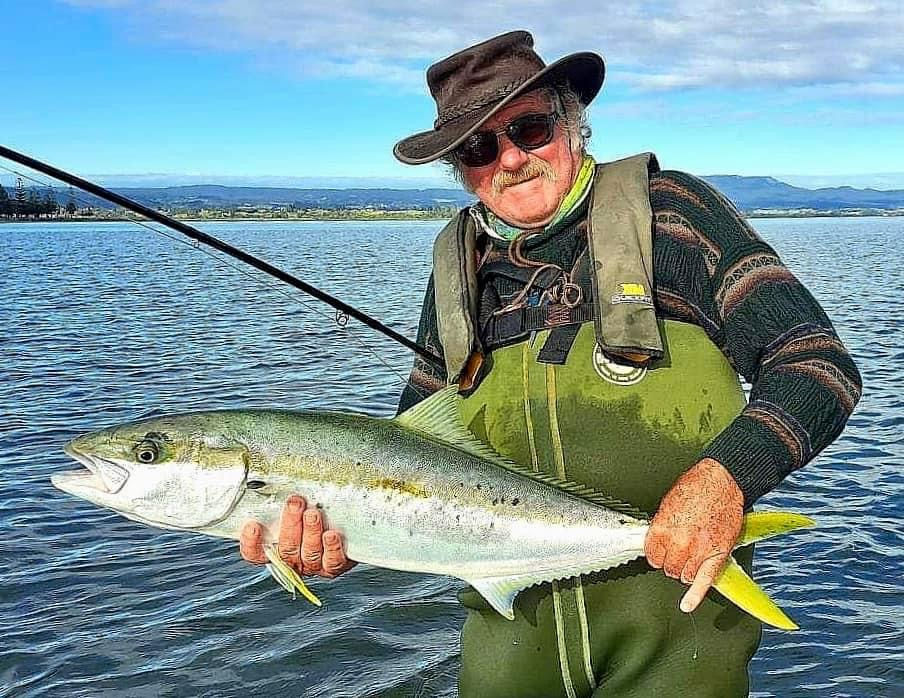
Kingfish on the fly maestro Dick Marquand, cradling a fabulous Tauranga flats Kingie.
The months ticked down, became weeks, then days, and eventually, jet lag vanquished, I awoke on the day I had appointed to surely fulfil my kingfish destiny. Alas, I seemed to have brought a sizeable dollop of prime Welsh ‘murk’ with me!
As my ever obliging wife dropped me at the boat ramp, a little ice cube of unease formed as the weather was of that type that any flats angler groans at; leaden skies and terrible light which plated the water like sheet lead. Sight fishing was going to be tough, bordering impossible.
Julian and I shook hands and acknowledged the tough task ahead. This was going to require every fish-finding trick in the flats book!
The usual route for the best shots at kingies was to find ‘Ray-riders’, groups of kingfish that closely followed the large, black, short-tailed stingrays over the pale sand, ambushing prey that the passage of the stingray dislodged.

Finding the stingrays involves quietly drifting or cruising the flats scanning for their distinctive black shape. A careful interception is then plotted, and a cast is to be placed 3 or 4 metres ahead of the ray’s direction of travel. The second the fly hits, either a retrieve is started to imitate a startled baitfish, or the fly is allowed to sink to the bottom then given a couple of quick strips and then slow pulls, as you would expect of a scurrying crustacean.
Of course that all rather depends on being able to see the stingrays! On this day, the gloomy, diffused light shrouded the water’s inhabitants so we started by reverting to plan ‘b’.

Under dreary leaden skies, sight fishing was nigh-on impossible... which meant reverting to plan-B.
Tauranga harbour has a number of channels threaded through it, the edges of which are denoted by large channel markers. It is often possible to pick up kingfish from these, as they take up temporary residence on the structures. Under instruction I cast a green popper fly close to the downstream side of the markers and ‘knocked on the door’, creating a loud surface disturbance with the fly to call the kingies out. But alas, every marker stayed quiet - there was no-one home.
Kingfish flies are pretty varied...

Poppers work well when conditions are right, 'calling' the fish out from cover and structures...
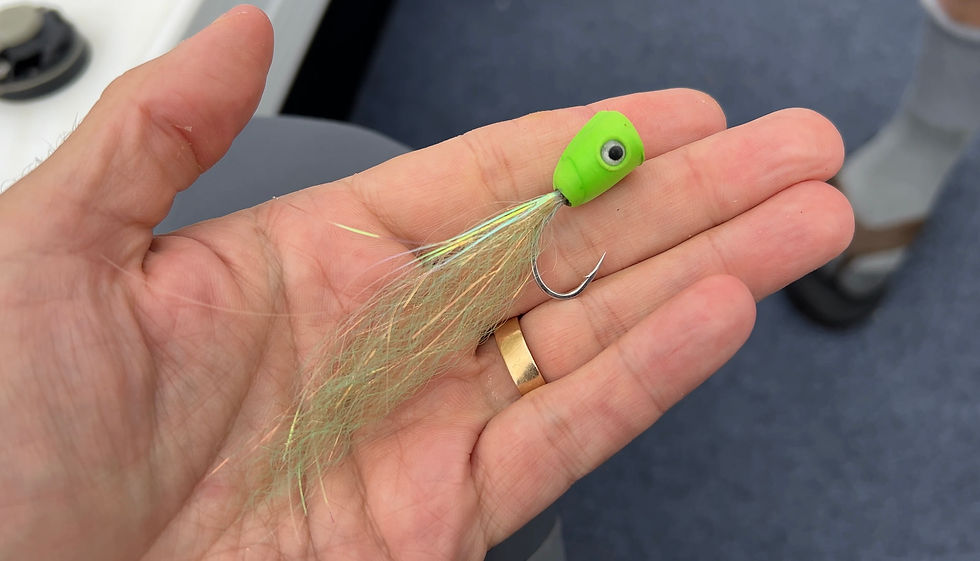
Many patterns are based around 'Piper' baitfish (known elsewhere in the world as Ballyhoo) which form a large part of the Kingfish's diet,

but I also used short, heavily dressed and weighted clousers with rubber or silicone legs, often in drab greens and browns, which work well as crustacean patterns. The fact is that most baitfish patterns will elicit a response if the kingies are up for it, and the fly is placed right and retrieved fast.
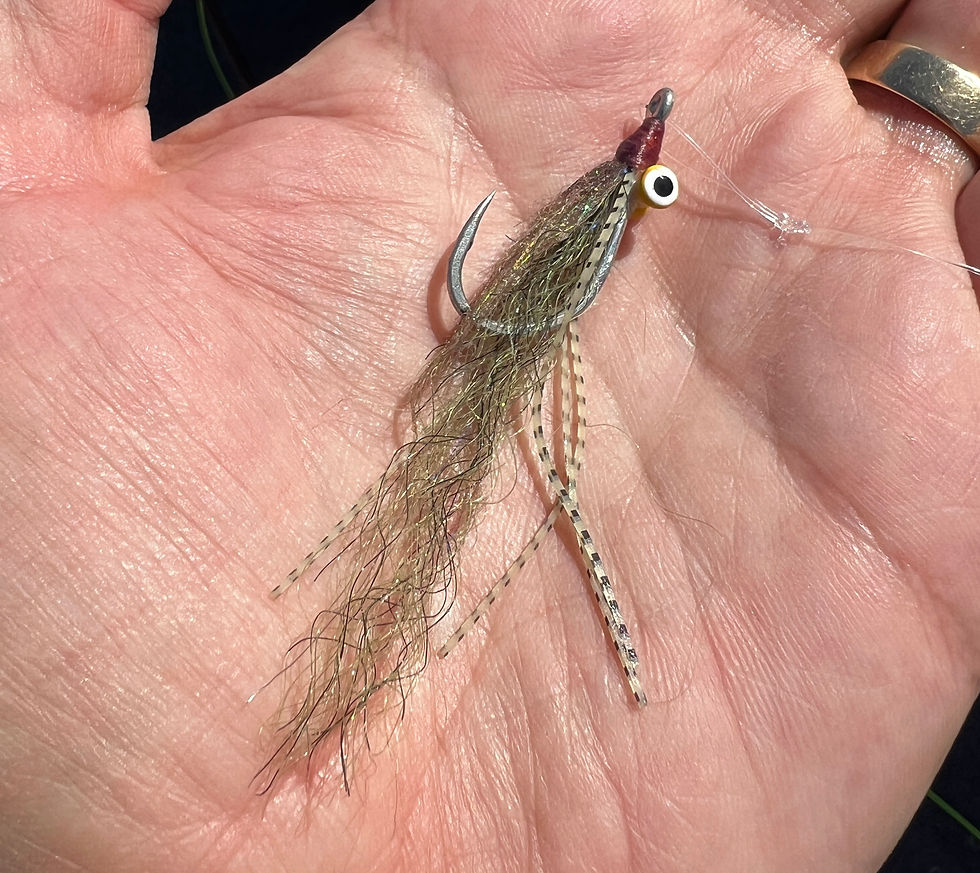
We then spent time quietly stalking the flats and shallow creeks and bays, but scanning the surface for bow waves and tails proved fruitless as our quarry skulked out of sight.
With time ticking by and visibility if anything worsening, we resorted to hugging the forested islands, using the dark reflection of the trees to provide a glimpse beneath the surface. This helped give a narrow window into the water and did allow us to spot a few of those sought after stingrays but not one had a rider. A cast into a brief commotion yielded a feisty kahawai, an aggressive, hard fighting and fun species on light gear, and on my list…but not the intended target.

A nice Kahawai I had on the fly a couple of days later - on light gear these fish are huge fun!
The day wound down, the pressure wound up, but it was not to be and we conceded defeat.
That left one more shot at the Tauranga flats, and 48 hours later I rolled up to the slipway under blue skies and barely a breath of wind - what a difference a couple of days made! Now, as Julian piloted the skiff over the gin-clear shallows, the sandy bottom shone as if lit from beneath, revealing its previously concealed contents for hundreds of metres in every direction.
I was jumping at every shape, many of which were majestic eagle rays. Normally these never carry riders, but Julian and I were both surprised to see one large eagle shadowed by two emerald green kingfish of a good size, though they were moving at speed and gone in a flash.

Ghostly eagle rays were abundant. Once a little closer, it's easy to spot the difference - the distinctive diamond shape and lighter brown colouring gave them away.
From this point, stingray sightings came regularly. Julian’s keen eyes could spot if a ray was carrying passengers and a number of stunning encounters ensued, with my guide calling out the shots and me trying to ensure a clean cast in the pulse-pounding heat of the moment; the sight of a school of kingies chasing a fly in glassy water is a heart-stopper! But for some reason, the fish were just not committing. Encounter after encounter presented the same astonishing sight, but no contact. Fly changes made no difference so Julian suggested a drop in leader breaking strain from 30 to 20lb.

Stingray, stingray! But has it got riders?
Some 20 minutes later I spotted a distinct black oval moving close to a patch of dark sea grass. “Get ready - It’s got riders!” urged Julian. The ray was gliding right to left and my first cast landed in the target zone and I began to strip the dark olive and brown clouser. Immediately several large shapes broke away from the ray and came tearing towards the fly. I was treated to an incredible view of those deep green backed and bronze lateral striped torpedoes as they homed in like missiles, and a fraction of a second later the line locked-up in my hand and I strip-struck into my first kingfish!
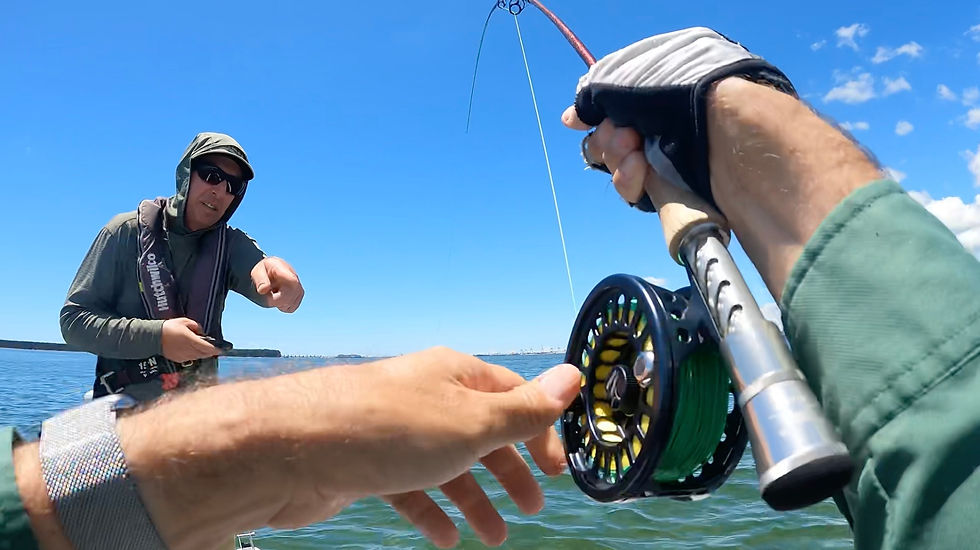
The clearly hefty and irate kingie surges off effortlessly against stiff clutch resistance as Julian gives expert advice
The reaction was immediate and decisive! Against considerable clutch pressure, the fish effortlessly ripped flyline off the reel, and send the backing knot rattling through the guides.
“That’s bigger than most!” exclaimed Julian. My pulse rate doubled again!
Backing continued to peel inexorably from my spool. Under advice I cranked up the pressure even more, but still the fish powered on and I began to glance worriedly at the fast diminishing reserve of line. Julian jumped onto the bow mounted electric outboard and we chased the marauding king down as best we could. My arm and shoulder were now seriously aching and the brutal tug of war continued for what seemed like an age, the line thrumming in the current under the intense pressure. The kingie made run after run against a clutch I daren’t tighten any further. I was now groaning and complaining as the lactic acid in my arm caused my muscles to scream. But I could sense the fish tiring and I began to recover more line than he took.
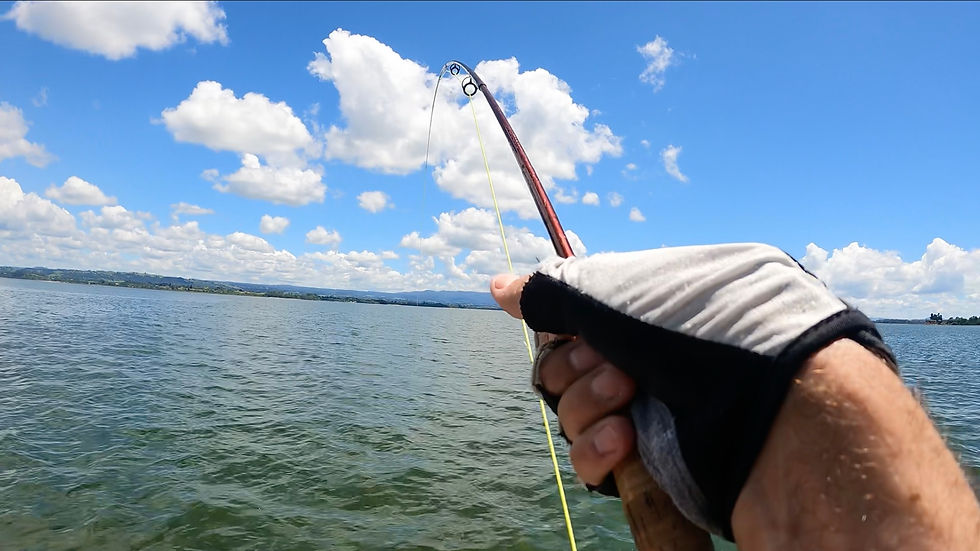
Arm and shoulder screaming, I could sense I was getting the upper hand...
Julian warned me the kingfish would likely try and go under the boat so he raised both engines and we were at the mercy of the currents. I could now see the fish - and it was a good one, easily 80-85cm according to Julian’s expert eye. He grabbed the net and with just a few rod lengths of line out, heart pounding and mouth dry, I prepared for the end-game.
And at that point… the rod tip bounced up and the line went slack!
I let out an agonised “Oh nooooo!” whilst Julian laid down the net and put his face in his hands.
“The hook must have pulled.” I said flatly. There were a few moments of silence before he drew a breath and said “Right.. let’s find his mates!”.
Another 20 minutes slipped by and I massaged my burning shoulder as I scanned the flats. Eventually we drifted toward a bunch of fly anglers wading the flats. The nearest turned out to be Dick, and he commiserated as I recounted my tail of woe, before urging us on to try again.
We resumed our hunt and it wasn’t long before I spotted another dark patch in the distance and Julian steered us to investigate.
“Yep, it’s a stinger and she’s carrying kingies!” he yelled.

Yep, it's got riders!!
As we turned onto the path of the ray, we could both clearly see flashing flanks of active fish surrounding it. The ray made a sudden change of direction and started straight towards the boat. Julian cursed but urged a cast. I hurriedly flicked the line out and stripped. Immediately the 6 kingies responded and exploded forward. They then hesitated… “Pause…now strip!” yelled my guide. I obeyed and the lead fish committed and again the line went tight and slammed into reverse.
I’m well versed in the routine - rod held high once the fish runs, reel tilted handle-side down, left hand out wide to guide the line safely out as the fish accelerates. But then I noticed with horror the nasty and certainly ring-jamming knot in my running line fast approaching. I bawled at Julian “Knot! There’s a Knot…!” just as it hit the rod and everything lurched violently to a halt, surely with a leader-snapping jolt. But somehow it held and the kingfish turned and ran straight at us!
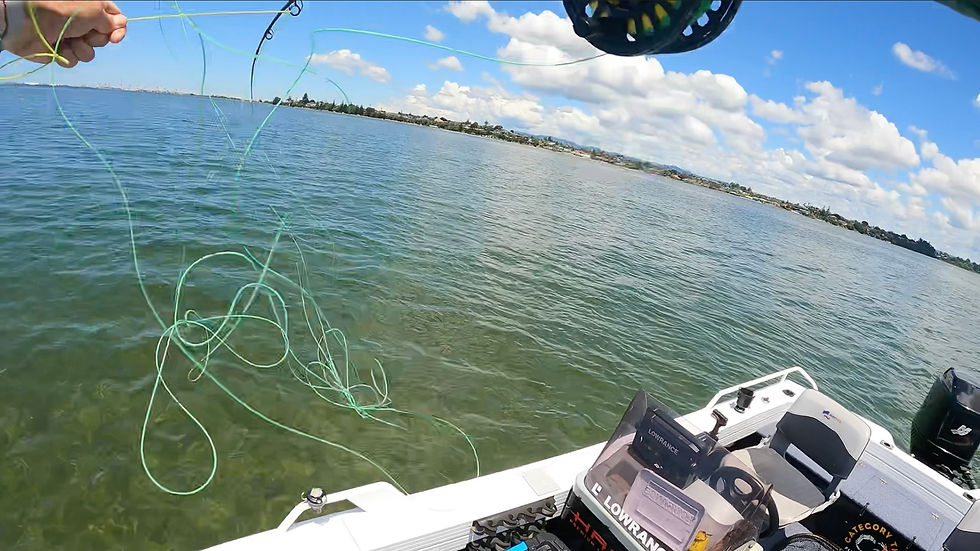
Uh-oh.... that ain't good!!!
I yanked the knot out of the guides and Julian grabbed the line and rod as I shouted “See if you can un-pick it, I’ll handline!’
Well that was easier said than done! The enraged kingie made searing runs which I had no choice but to try and arrest, the textured line giving painful friction burns as it tore through my hands.

Boy, did I wish I'd worn TWO gloves!
I stumbled frantically around the boat trying to control the kingfish as it seemed hell bent on trying to snap the leader against the hull, engine and anything else it could find, as Julian feverishly picked at the tangled mess in his hands. After what felt like an eternity he yelled “Done it!” and I gratefully took the rod in burning fingers and laughed in disbelief that the fish was still on!
Suffice to say the yell of joy when the net went under that kingie was truly unbridled and we both beamed at each other in relief!

After 6 minutes of utter chaos, it was in the net!
“That has got to be the most bizarre way I have caught a bloody fish in my entire life!” I chuckled!
It was a decent fish - not anywhere near the size of the one I lost, but under the circumstances that’s probably just as well! It was, however, absolutely stunning. My first kingfish was admired and recorded for posterity before being gently released back to his chums.

I had a couple more shots before we finished, but the remaining kingfish were just not hungry, so we made our way back to the slipway in a suddenly strengthening breeze, thankful for the perfect conditions throughout the day.
So, to pick up where we started, did it live up to my expectations?
Hell, yeah!
__________________________________________________________________________________
If you get an opportunity to visit New Zealand, grab it with both hands. It is an extraordinary country, and the flyfishing opportunities are sublime - both in the world renown rivers, and their bountiful seas too! If you're visiting angler on a family holiday (with a busy schedule), employing the services of a good guide is always worth the investment. Julian Danby comes highly recommended, and can put you on the fish both in salt and freshwater. Take a look at his details here: https://rotoruatroutguide.co.nz/




Comments